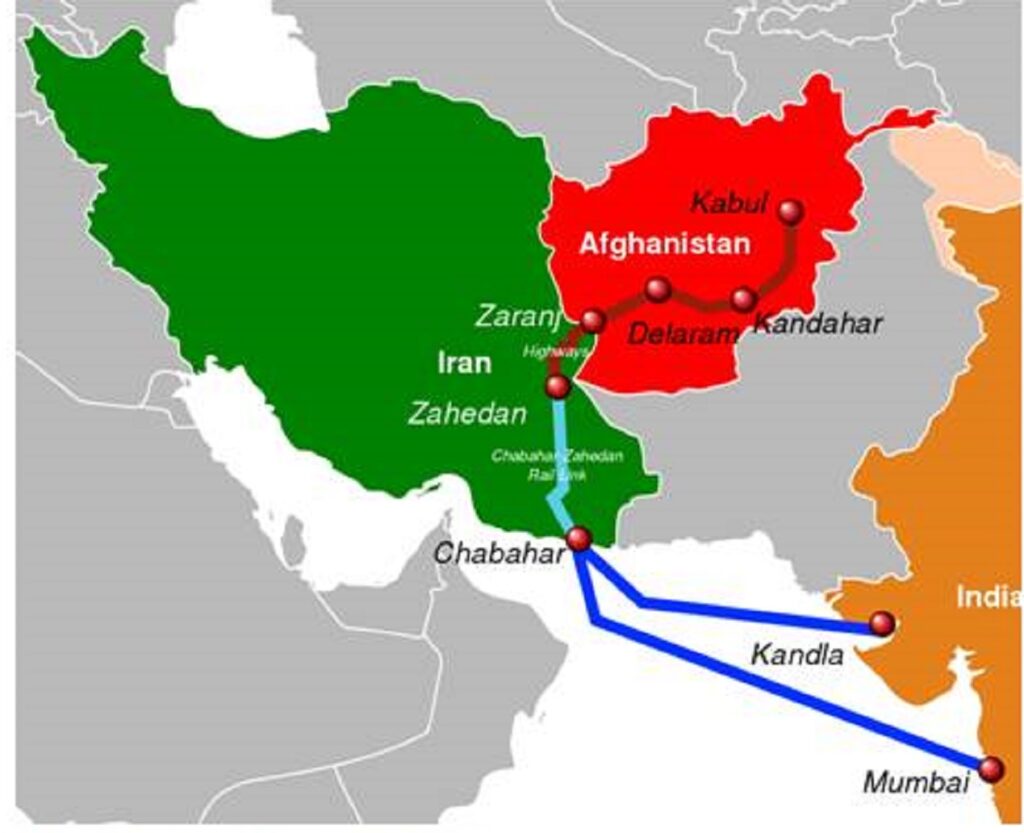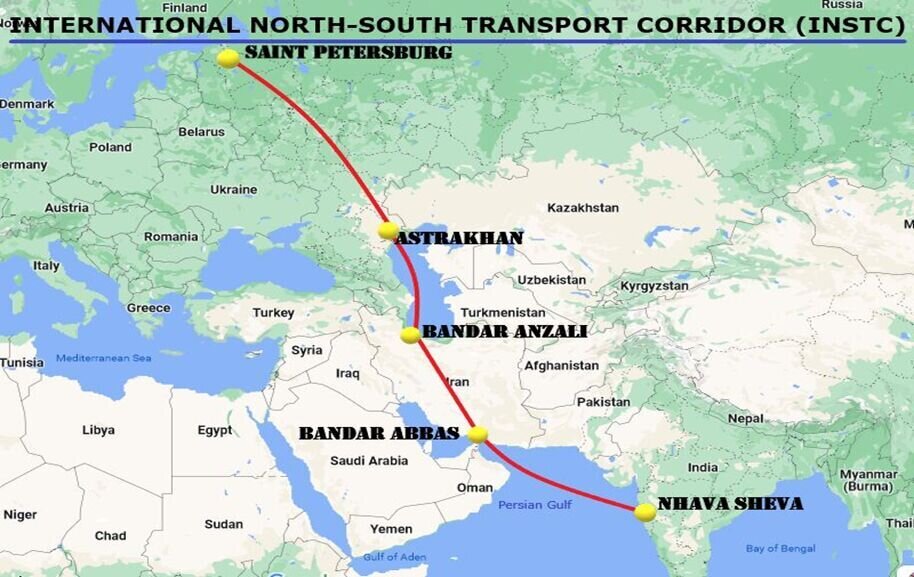
- Revival of the Chabahar-Zahedan Railway Project: Iran and India are discussing reviving the railway project to connect Chabahar and Zahedan, recognizing the strategic and economic benefits amid shifting geopolitical dynamics.
- Economic and Strategic Benefits: The Chabahar Port, funded by India, has seen significant growth in container traffic, highlighting its commercial viability and strategic importance in linking India to Central Asia via the International North-South Transport Corridor (INSTC).
- Geopolitical Shifts and China’s Influence: Iran is reducing its reliance on China, influenced by the negative impacts seen in other countries involved with China’s Belt and Road Initiative (BRI). The successful operation of Chabahar Port and the railway project poses a strategic threat to China’s regional dominance.
- India’s Diplomatic Balancing Act: India’s ability to maintain strong relations with Iran while being friendly with Israel, the USA, and other Western countries showcases its diplomatic skill in protecting its strategic interests and enhancing its regional dominance.
The Chabahar-Zahedan Railway Project, initially reclaimed from India by Iran in 2020 due to Chinese pressure, is once again being discussed, which is in contrast to expectations. High-level government officials have stated that Iran and India want to revive the project to connect Chabahar and Zahedan by train. Iran’s strategic calculations may have to shift in light of India’s effective management of the Chabahar Port, which has seen traffic grow sixfold.
Indian Railways IRCON and the Iranian Railway Construction and Development of Transportation Infrastructure Company signed the Memorandum of Understanding (MoU) in 2016. The agreement involved financial support by India towards a railway line from Chabahar to Zahedan. Even then India was investing in Afghanistan, building connectivity from Iran to Central Asia thus diversifying away from the POK.
The Initial Vision and Subsequent Challenges
The initial vision was ambitious. The aim was to connect India to Central Asia through Afghanistan and thereby emphasise infrastructure development in Afghanistan. This connectivity was planned to be connected with the North-South International Transport Corridor (INSTC), a development initiative aimed at promoting trade between Russia, the Central Asian states and India. However, several challenges emerged. Afghanistan remained unstable and particularly the return of the Taliban, posed a challenge to any infrastructural advancement in the region. Moreover, the political barriers in the Indian government created problems for Iran in achieving the necessary financing, as the funds were held up by bureaucratic procedures, and for this reason, Iran shifted its focus to China with a strategic partnership agreement of $400 billion over 25 years.
Changing Geopolitical Dynamics
This has however not been the case in recent events that have seesawed the balance. Iran is also reducing reliance on China for funding, acknowledging the trends witnessed in Malaysia, Nepal, Pakistan, and Sri Lanka which have fallen into a debt trap by China. Also, the apparent Western media pressure on China hurts its image and yet another economic crisis seems to be brewing in China.
On the other hand, Iran’s concern to sustain its oil supplies to India, one of its primary customer countries, has revived its interest in New Delhi. As with any long-term and far-sighted infrastructure strategy, the advantages of linking Chabahar with Zahedan are gradually emerging as strategically and economically compelling. Iran is more interested in reviving the railway project due to the sharing of potential profits related to the operation of Chabahar Port which has benefited India and become commercially viable with enhanced container traffic.
Chabahar Port: A Strategic Asset
For instance, the Chabahar port in Iran funded by India saw its year-on-year (y-o-y) aggregate figures of container traffic comparison for FY24 reach 64,245 TEUs where it grew by an astonishing 600%. This is a higher performance mark compared to the 9,126 TEUs achieved in the previous year. Briefing about the present and plans, the officials of the Ministry of Chabahar said that 9,973 TEUs during the first two months of FY25 (April and May) from Chabahar port at present is 10 per cent higher than the FY23 total. “Current operation of Chabahar is feasible now in commercial terms and it is likely to become commercially sustainable soon,” the official of the Shipping Ministry said. Chabahar Port is situated in the southern part of Iran’s Sistan and Balochistan province, on the northern coast of the Gulf of Oman, and it is Iran’s sole deep-draft sea port on the maritime route to the Indian Ocean. India also has a terminal at Shahid Beheshti port through its subsidiary under a special purpose vehicle called India Ports Global Ltd (IPGL).
Gwadar Port: A True Untold Story of Economic Betrayal
The case of the Pakistani Gwadar port has been considered as one of the promising projects of Chinese BRI, however, corruption and various financial and logistics issues have caused problems there. Although Gwadar has other advantages, including a seemingly strategic location as a deep-sea port, the port only provided shelter to seventeen ships in 2023 and is regarded as the weakest funded port by China. A promised $1.6 billion refinery planned at Gwadar in 2015 has not shown much activity and the goal of developing Gwadar port city has not been achieved. Infrastructural development and industrialization through the China-Pakistan Economic Corridor (CPEC) project, which includes the development of Gwadar as a deep-sea port city to facilitate trade and economic activities along over 2,000-kilometer long corridor, has been affected by Political instability and charges of corruption.
The Revival of the International North-South Transport Corridor (INSTC)

The International North-South Transport Corridor which can be deemed as a relatively antiquated idea is now receiving reconsideration. As a network for the movement of its freights, it is a 7,200-kilometer-long multi-modal system that connects India, Afghanistan, and Azerbaijan with Iran, Russia, Central Asia and even Europe. Russia’s attention is now clearly on the Indian market due to sanctions, and this means that the underlying infrastructure must be secure. Still, recently, the first convoy of coal from Russia was delivered to India through the INSTC; Russia is also actively working on the extension of the railway connection between Azerbaijan and Iran. This comes hand in hand with the reduced impact of the Taliban who are now seeking investment from India to foster stability in the region.
Strategic and Economic Consideration of the Railway Project
The Chabahar-Zahedan railway line is vital for connecting Chabahar to the INSTC and creating strong linkages from India to Russia through Iran. India’s newfound interest towards the project indicates a shift in its policy for the protection of its interest in Central Asia. The INSTC is a shorter and cheaper route compared to the Suez Canal aimed at dramatically increasing trade relations between India, Iran, Russia, and other countries. The potential capacity to traffic 20-30 million tonnes of goods per year offers a promising economic prospect for the corridor.
For India, the INSTC improves access to Central Asian markets without the necessity of going through Pakistan, which is critical because it offers a strategic answer to China’s increasing dominance in the region. Thus, the operational functioning of Chabahar Port and its inclusion into the framework of the INSTC can be considered as a significantly more successful paradigm of international relations cooperation, and development than it is typical for the Chinese Belt and Road Initiative.
Balancing Relations: India, Iran, and Global Allies
Indian diplomacy’s capacity to balance its relations with Iran as a strategic partner while being a friendly nation to Israel, the USA and other Western countries is very good diplomacy. India has been able to protect its strategic interests in Iran and still has good relations with countries that have hostile relations with Iran. This delicate act not only strengthens India’s regional dominance but also protects its energy and trade corridors, which helps it achieve its strategic and developmental vision for the future.
A Nightmare for China
Therefore, the renewal of the Chabahar-Zahedan railway project and the proper functioning of the Chabahar Port pose a strategic threat to China. That is why, if Iran stops raising Chinese funds and starts turning to India, the influence of China in the region could decrease. The INSTC, which is an attempt to offer an alternative to the BRI, has the potential to divert substantial trade flows away from Chinese-controlled facilities, thus challenging Beijing’s geopolitical agenda. India which is stabilizing its presence in Central Asia and Iran is becoming a serious rival to China’s Belt and Road Initiative, which may change the balances in the regional economic landscape to China’s detriment.
Conclusion
The rejuvenation of the Chabahar-Zahedan rail project is one of the most significant events in the strategic engagements of India. As geopolitical realities change, a new chapter of cooperation between Iran and India might redefine the connection in terms of economic development and security. The emergence of Chabahar Port and the revival of INSTC is an indication of the possibilities of India expanding its strategic presence in Central Asia for a new era of strategic cooperation and economic integration.
